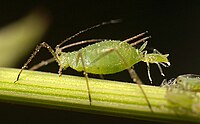
Photo from wikipedia
This study focuses on the possibility that herbicide-exposed phytoplankton will cause sub-lethal effect on zooplankton. Atrazine, phytoplankton Raphidocelis subcapitata and zooplankton Daphnia magna were chosen as a model chemical and… Click to show full abstract
This study focuses on the possibility that herbicide-exposed phytoplankton will cause sub-lethal effect on zooplankton. Atrazine, phytoplankton Raphidocelis subcapitata and zooplankton Daphnia magna were chosen as a model chemical and organisms. R. subcapitata was exposed to atrazine at 150 μg/L, harvested and fed to D. magna. While the mothers fed with atrazine-exposed phytoplankton did not show any abnormalities, they produced non-viable offspring. Number of non-viable offspring at the first clutch was high but the number was reduced at later stages and viable offspring was produced. This result indicates that phytoplankton exposed to sub-lethal dose of atrazine affects population dynamics of its predator, D. magna.
Journal Title: Marine environmental research
Year Published: 2019
Link to full text (if available)
Share on Social Media: Sign Up to like & get
recommendations!